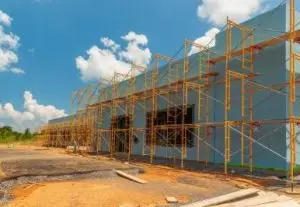Looking to build a strong and stable scaffold? Check out this comprehensive construction checklist.
What is scaffolding?
Scaffolding is a temporary structure used to support people and materials during the construction, repair, and maintenance of buildings, bridges, and all other manmade structures. It is usually made of wood, metal, or a combination of the two. There are four main types of scaffolding:
- Support scaffolds provide vertical support for working platforms.
- Bracket scaffolds are attached to the face of a structure.
- Suspended scaffolds are hung from an overhead structure.
- Trestle scaffolds are freestanding frames.
Scaffolding must be designed and built by a qualified person in accordance with applicable safety standards.
Scaffolding Checklist
This scaffolding construction checklist is intended to help you ensure that your scaffolding structure is safe and stable. Please use this checklist as a guide when inspecting your scaffolding, and make sure to consult with a professional if you have any questions or concerns.
Follow these steps:
1. Check the base plates of the scaffolding to ensure that they are level and evenly spaced.
2. Ensure that all of the uprights (vertical members) are plumb (vertically straight), and check that they are securely fastened to the base plates.
3. Make sure that all of the horizontal members (ledgers and transoms) are securely fastened to the uprights, and check that they are level and evenly spaced.
4. Inspect the joint pins or clamps to ensure that they are secure and correctly fitted.
5. Check all of the braces (diagonal members) to ensure that they are taut, properly positioned, and securely fastened.
6. Inspect the platform(s) to ensure that they are level, evenly spaced, and securely fastened to the horizontal members.
7. Ensure that there are at least 18 inches of space between the platform(s) and the horizontal members above them.
8. If applicable, check any guardrails or toe boards to make sure they are properly installed and secured.
Working at height on scaffolding can be dangerous, so it’s important to be aware of the potential risks and take the necessary safety precautions.
Additional scaffold safety tips include:
- Always wear the correct personal protective equipment (PPE), including a hard hat, safety glasses or goggles, and hearing protection.
- Only use scaffolding that has been erected by a qualified professional.
- Don’t overload the scaffold – always check the maximum load capacity before use.
- Be aware of potential hazards when using scaffolding, such as overhead power lines, traffic, and uneven ground.
- Never leave tools or materials on the scaffold – they could fall and injure someone below.
- If working in windy conditions, tie down or secure the scaffold to prevent it from toppling over.
Follow these safety tips and enjoy a safe and productive working environment on your next scaffolding project.
The history of scaffolding
Scaffolding is a temporary structure used to support people and materials during the construction, repair, and maintenance of buildings, bridges, and other large structures. It is usually made from wood, metal, or aluminum. The word scaffold came into English in the late 15th century, from the Old French word escafaud, which in turn derives from the Italian scaffalatura or Spanish escalera, both meaning “ladder”.
Scaffolding equipment dates back to ancient Egypt where it was used for raising obelisks and other heavy construction during ancient Egyptian times. The Berlin Papyrus illustrates Pharaoh Djoser’s tomb from Giza circa 2630 BC and has numerous illustrations of ladders suspended from poles.
Scaffolds were not just used for construction, but also for warfare. During the American Revolutionary War, scaffolding had been used to hold cannon batteries to fire on forts.
Scaffolding had also been used in mining operations during the 1st and 2nd industrial revolutions. Scaffolding was extensively used in London in fixing the lead flats on top of Buckingham Palace after it was destroyed by burning balloons dropped by the European Arians during World War II.
The benefits of scaffolding
Scaffolding provides a safe and secure working environment for construction workers and is an essential part of any construction project. In addition to the obvious safety benefits, scaffolding can also improve work efficiency and quality, while reducing project costs.
When used correctly, scaffolding can:
- Significantly reduce the risks associated with working at height.
- Improve productivity by providing a safe and efficient working platform.
- Improve work quality by ensuring that work is carried out correctly.
- Reduce project costs by reducing the need for costly reworks.
The dangers of scaffolding
Scaffolding can be dangerous if it is not set up properly. It can also be dangerous if a worker does not have a fall arrest system in place. Falling from scaffolding can cause serious injury, even death to the worker that falls and anyone below. Tools can also fall off scaffolding and land on people, vehicles, or buildings, causing damage.
The different types of scaffolding accidents
There are four main types of scaffolding accidents:
1. Collapses – this is when the scaffolding structure itself collapses or falls over.
2. Falls – a worker falls off the scaffolding, either through a hole in the platform or because they have not used their safety harness correctly.
3. Falling objects – tools or other materials fall from the scaffold onto workers or passers-by below.
4. Electric shocks – if the scaffolding is not correctly earthed, workers risked being electrocuted if they come into contact with live electrical cables.
In Closing
Scaffolding will work to prevent falls and injuries, but only if properly used. Make sure to follow this checklist before attempting to use a scaffold while working at heights.

